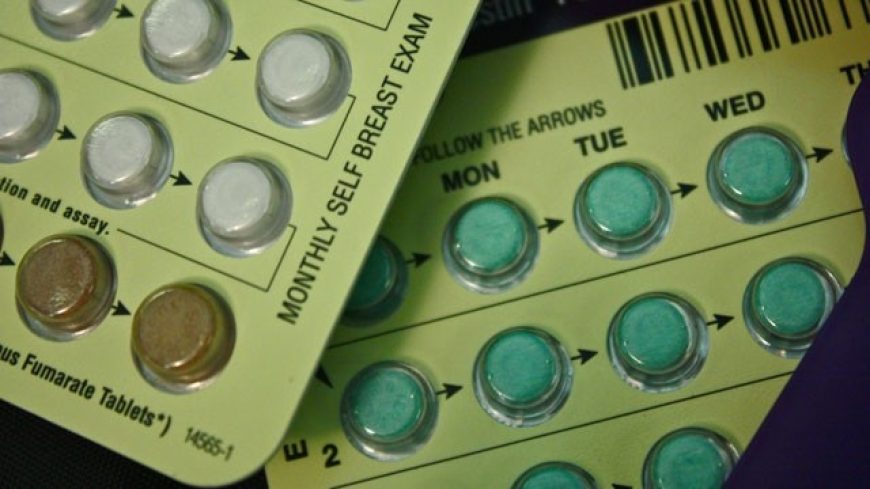A Word of Advice:
- No birth control method is guaranteed to work 100% of the time, except for abstinence (not having sex).
- Most types of contraceptives do not offer protection against STDs. Using a condom every time is an effective way to reduce your risk.
- No matter which method you choose, make sure you follow the instructions carefully to maximize its effectiveness
Below are some common methods for birth control. Discuss with your health care provider about other options and find out which method is the best for you.
Oral Contraceptives (Birth Control Pills)
Birth control pills are small tablets that women take once daily to prevent pregnancy. They are considered a very effective and convenient means of contraception. There are many different types of birth control pills, but they all work in a similar way: they contain one or more female hormones that stop ovulation (the process through which the ovary releases an egg) and prevent sperms from reaching the egg. Birth control pills do not protect you against sexually transmitted disease (STD) infections. These pills may not be appropriate for women with certain medical conditions, such as hepatitis and heart disease. Bear in mind that other prescription medications can decrease the effectiveness of birth control pills. Make sure you check with your health care providers.
A doctor’s prescription is required to purchase birth control pills. The pills usually come in packs of 28 tablets, to be taken in a 4-week cycle: 21 active hormone pills followed by 7 placebos (containing no active hormones). When taken as scheduled, you should have your menstrual period in the fourth week. However, this schedule may vary for certain types of birth control pills. Ask your health care provider for specific instructions and always take the pills as directed.
Male Condoms
A male condom is a thin plastic sheath worn over a man’s penis during sexual intercourse to block semen from entering a sexual partner’s body. Since ejaculated semen remains inside the condom, sperms will not enter the woman’s vagina and cannot cause pregnancy. Male condoms are very inexpensive, convenient to purchase and use. They are considered one of the most common methods for birth control. Since condoms cover up the penis and prevent exchange of bodily fluids during intercourse, they can also effectively reduce the risk of STD transmission. Male condoms are usually made of latex, but those made of polyurethane are available for people allergic to latex. They can be used together with a lubricant and spermicide. It is also important to choose the right size condoms to optimize their effectiveness.
Important Advice on Condom Use:
- Always use a condom when you have sex, and use a new one for each erection.
- Store condoms in a cool, dry environment—not in a wallet, pocket or anywhere with heat.
- Do not use a condom from a torn or open package.
- Put the condom on before the penis comes in contact with your partner, because a small amount of fluid may leak even before ejaculation.
- Most condoms are made of latex, and only water-based lubricants should be used with them. Oil-based lubricants can cause latex condoms to break.
- Do not use two condoms at the same time. The friction in between may cause them to tear.
- If the condom breaks during intercourse, pull out right away and replace with a new one.
- If the condom breaks and semen leaks out, emergency contraception (such as Plan B) may be necessary to prevent pregnancy.
Female Condoms
A female condom is a thin plastic pouch worn inside a woman’s vagina during sexual intercourse. At its closed end, a soft ring helps to keep the condom in place during intercourse. There is another ring at the open end, which stays outside of the vagina and covers up the area around the vaginal opening. Female condoms work by blocking the male semen from entering the vagina, so that sperms cannot reach an egg to cause pregnancy. By preventing the exchange of semen and vaginal fluids, female condoms also reduce the risk of STD transmission. Unlike birth control pills, female condoms do not change a woman’s hormone levels and do not require a doctor’s prescription. They can be easily purchased at local drug stores. Female condoms can be used together with a lubricant and spermicide.
Spermicide
Spermicide is a chemical substance used inside a women’s vagina during sexual intercourse to kill or disable sperm. It prevents pregnancy by keeping sperm from fertilizing an egg. Spermicide comes in different forms, including foam, cream, gel, film, and suppository. The product should be inserted deep into the vagina before sexual intercourse begins, as it may take some time for the chemical to become effective. The exact timing and instruction of use vary among products. Make sure you carefully read and follow all directions to maximize the product’s effectiveness. Spermicide can be used alone, but it is much more effective when used with another form of contraception, such as a condom. Because it does not prevent skin contact or the exchange of bodily fluids, spermicide does not offer protection against STD infections. Spermicide is inexpensive and can be purchased at local drug stores without a prescription.
Vaginal Ring (NuvaRing)
A vaginal ring is a flexible ring, about 2 inches in diameter, inserted into a woman’s vagina once a month to prevent pregnancy. After insertion, the ring is left in the vagina for three weeks. It is removed at the beginning of the fourth week, during which the woman will have her menstrual period. The process is then repeated using a new ring at the end of the fourth week. Most women find vaginal rings easy to insert and remove, and comfortable to wear—they usually cannot feel the rings at all. Each vaginal ring contains two types of female hormones that are commonly used in oral contraceptives. While inside the vagina, the ring continuously releases the hormones to prevent ovulation (the process through which an ovary releases an egg) and fertilization (the process through which an egg is joined by sperm). Vaginal ring is a convenient and effective method of contraception. But similar to birth control pills, a doctor’s prescription is required for purchase. Vaginal rings do not offer protection against STD infections.
Plan B
Also known as “the morning after pill,” it is a form of emergency contraception. It should be taken within 72 hours after sexual intercourse. Plan B contains a hormone found in many birth control pills, and it works to reduce the chance of pregnancy by stopping ovulation, blocking the sperm, or preventing fertilization. It is not an abortion pill, and it will not work if you are already pregnant. It also does not protect again STD infections. Plan B can be used after you have had unprotected sex (you did not use any type of contraception) or as a backup to your regular birth control (when you forgot to take your birth control pills). However, Plan B should not be taken consistently to replace routine methods of contraception because it is not as effective.
Plan B is usually available in local pharmacies. No prescription is needed for women over 18, but the pharmacist may ask to check your ID card. If you are below 18, you will need a doctor’s prescription to buy the product. You may want to talk with your health care provider and obtain a prescription in advance, just in case an emergency occurs.
Resources:
- Planned Parenthood: http://www.plannedparenthood.org/
- Advocates for Youth: http://www.advocatesforyouth.org/
- Sex Ed Library: http://www.sexedlibrary.org/




